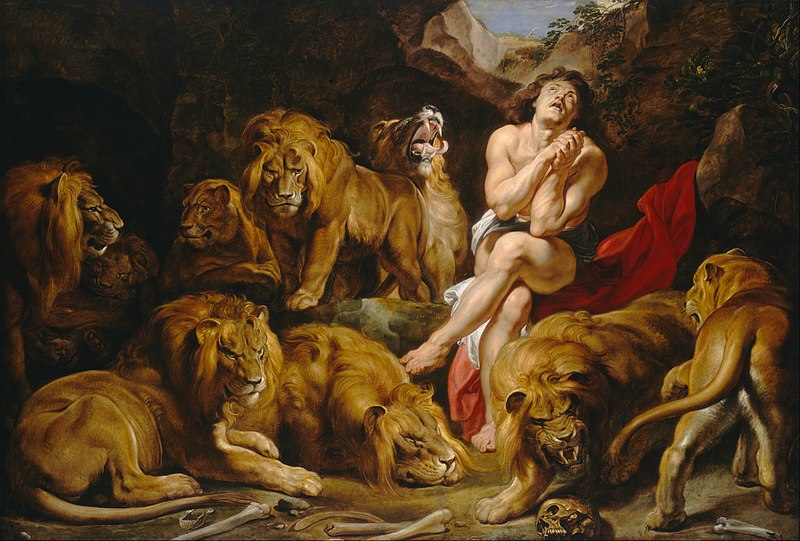Continuing the theme: - Praying the Our Father -
My earliest and happiest memories are of going to visit my grandfather. It wasn’t because he played games with me, gave me my favourite chocolate or even money to buy myself an ice cream on the way home, it was just because I loved him. He was such a lovable kindly man that it was more than enough just to be with him and feel myself enveloped by his love. This was before I even went to prep school. read on....
http://davidtorkington.wordpress.com
http://www.davidtorkington.com
Wednesday, April 30, 2014
Friday, April 25, 2014
Some Consideration of the Heroic Virtues of Pope St. John Paul II
At his funeral in St. Peter's Square in 2005, there were prolonged chants from the multitude gathered for “Santo Subito” (Sainthood Now!). On April 27, 2014, the Catholic Church celebrated the canonization of the 264th pontiff Pope St. John Paul II (born Karol Józef Wojtyła) along with the 262nd Vicar of Christ Pope St. John XXIII (ne Angelo Giuseppe Roncalli) in St. Peter's Square in Vatican City.
 |
| Three American Presidents paying respects to Pope John Paul II, April 2005 |
Some Protestants bristle at the notion that the Church “makes” saints, as nobody (but Christ) is perfect and that we are all supposed to be called to sainthood in our Christian identity. Certainly our baptism marks us as part of the Lord’s people and calls us to holiness. The Catholic Church can recognize, based on investigation and guidance from the Holy Spirit, that a person is already a saint, definitely in heaven and having led a life of great holiness that is worthy of veneration by the faithful. Canonized
saints are important examples to the faithful of how to live a heroic (not perfect) Christian life.
Pope John Paul II was a remarkable man who wore many hats in his life. He was a Laborer, Thespian, Playwright, Patriot, Priest, Philologist, Philosopher, Pilgrim, Bishop, Theologian, Sportsman, Scholar, Statesman and Vicar of Christ. The cause for John Paul II's canonization however is not premised on doctrinal dissertations, academic accolades or even geopolitical accomplishments.
It is about how John Paul II lived his life to reflect the Christian virtue which still touches the faithful today.
After several years of investigation led by postulator Monsignor Slawomir Oder, the Vatican’s Congregation for the Causes of Saints recommended Servant of God John Paul II’s heroic virtue to the Pope. On December 19, 2009, Pope Benedict XVI proclaimed John Paul II as “Venerable”. The Church normally requires that one miracle is attributable to intercessions of a Venerable, but the Vatican only investigates possible miracles after a candidate is declared Venerable. These miracles are almost always miraculous medical cures as these are the easiest to verify.
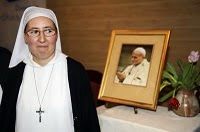 |
| Sr. Marie Simon Pierre |
[***]
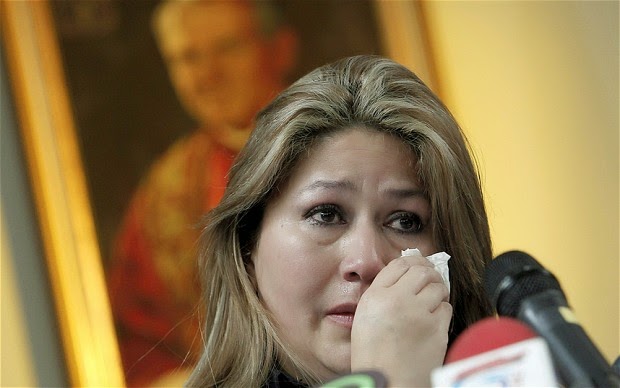 |
| Floribeth Mora Diaz |
[***]
The date of the canonization may well have been chosen because it was the 2nd Sunday of Easter, which Pope John Paul II instituted during his Papacy as “Divine Mercy Sunday”, due to his Devotion to St. Faustina Kowalska (1905-1938). The vigil mass of the feast of Divine Mercy had just been celebrated at John Paul II’s bedside when he fell into a coma and soon after died.
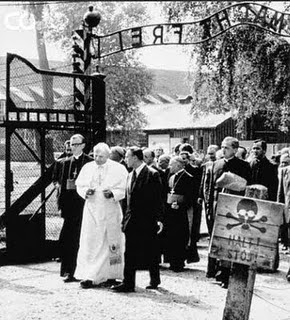 |
| Pope John Paul II at Auschwitz (1979) |
[***]
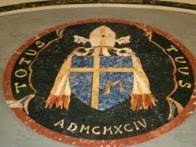 Then Cardinal Karol Wojtyła was elected Pontiff in October 1977 during the Year of Three Popes. While Pope John Paul II was the first non-Italian pope in 454 years and was from a nation behind the Iron Curtain, he was chosen because of his theology. John Paul II chose as his papal motto “Totus Tuus”, which reflected his Reflected his personal consecration to Mary which was based on the spiritual approach of St. Louis de Montfort (1673-1716)—“Totus
tuus ego sum, et omnia mea tua sunt" ("I am all yours, and all that I have is yours"). In Crossing the Threshold of Hope, he explained that the “Totus Tuus” motto expressed the understanding that he “[c]ould not exclude the Lord's Mother from my life without neglecting the will of God-Trinity”. Polish born composer Henryk Gorecki (1933-2010) wrote the choral
piece “TotusTuus” in honor of Pope John Paul II’s 3rd visit to Poland in 1987.
Then Cardinal Karol Wojtyła was elected Pontiff in October 1977 during the Year of Three Popes. While Pope John Paul II was the first non-Italian pope in 454 years and was from a nation behind the Iron Curtain, he was chosen because of his theology. John Paul II chose as his papal motto “Totus Tuus”, which reflected his Reflected his personal consecration to Mary which was based on the spiritual approach of St. Louis de Montfort (1673-1716)—“Totus
tuus ego sum, et omnia mea tua sunt" ("I am all yours, and all that I have is yours"). In Crossing the Threshold of Hope, he explained that the “Totus Tuus” motto expressed the understanding that he “[c]ould not exclude the Lord's Mother from my life without neglecting the will of God-Trinity”. Polish born composer Henryk Gorecki (1933-2010) wrote the choral
piece “TotusTuus” in honor of Pope John Paul II’s 3rd visit to Poland in 1987.
From the start of his Petrine ministry until his eventual death from Parkinson’s Disease 26 ½ years later, John Paul II’s message to the faithful was the Lucan exhortation “Be not afraid”. In fact, John Paul II uttered the phrase three times during his homily at the Papal Inauguration. This message “Be not afraid… open the door wide to Christ” was chosen as the slogan for his beatification.
It was the same message that he brought when he first visited his homeland of Poland in June 1979. The documentary Nine Days That Changed the World showed the power that John Paul II message of “Be not afraid” had with the Polish people to instill the dignity of the individual to live out their faith and, with the guidance of the Holy Spirit, renew the face of the Earth and their land.
It was the same message that he brought when he first visited his homeland of Poland in June 1979. The documentary Nine Days That Changed the World showed the power that John Paul II message of “Be not afraid” had with the Polish people to instill the dignity of the individual to live out their faith and, with the guidance of the Holy Spirit, renew the face of the Earth and their land.
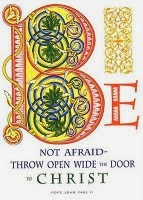 The millions of Poles who flocked to their favorite son's first pilgrimage back to his homeland showed that the faithful were not alone in that officially atheistic state and served as a real retort to Stalin’s taunt of “The Pope! How man divisions does he got?" Both Lech Walesa, the piously Catholic worker who lead
the Solidarity movement (and eventually became Poland’s President), and Vaclav Havel, the less spiritual leader of a free Czechoslovakia, credit the fall of the Iron Curtain to the message “Be not afraid” embodied in John Paul II’s 1st visit to Poland.
The millions of Poles who flocked to their favorite son's first pilgrimage back to his homeland showed that the faithful were not alone in that officially atheistic state and served as a real retort to Stalin’s taunt of “The Pope! How man divisions does he got?" Both Lech Walesa, the piously Catholic worker who lead
the Solidarity movement (and eventually became Poland’s President), and Vaclav Havel, the less spiritual leader of a free Czechoslovakia, credit the fall of the Iron Curtain to the message “Be not afraid” embodied in John Paul II’s 1st visit to Poland.
On May 13, 1981, Pope John Paul II was shot four times at close range and critically wounded in St. Peter’s Square by Mehmet Ali Ağca, a trained Turkish gunman. Many belief that this assassination attempt was a hit job coordinated by the Bulgarian
Secret Police with the complicity of the Kremlin. Yet less than two and a half years later, John Paul II met with Mehmet Ali Ağca and forgave the gunman on Christmas, 1983.
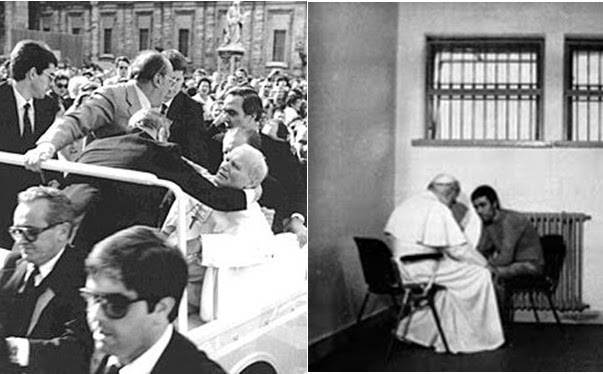 |
| [L] Pope John Paul II shot May 13, 1981, [R] Pope forgives Agca December 25, 1983 |
Pope St . John Paul II was convinced that Our Lady of Fatima kept him alive during the ordeal where he lost 3/4ths of his blood.
The Third Secret of our Lady of Fatima can be seen as predicting the assassination attempt on the Pope. The John Paul II’s
faith filled connection between his assassination attempt and the visions of Fatima that a bullet from his wounds now tops the golden finery of the Our Lady of Fatima processional statue.
One of the hallmarks of Pope St. John Paul II’s reign was being a Pilgrim as Vicar of Christ to proclaim Jesus as the Redeemer of Humanity to all the Earth. Frankly, he came pretty close to covering it all. It is speculated that the curia spent about a fourth of their time planning for and executing his 104 foreign trips to 125 countries which totaled 725,000 miles.
[***]
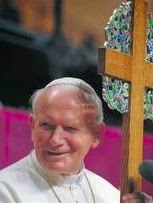 At the behest of Pope St. John Paul II, World Youth Days were held every couple of
years at rotating international locations. Skeptics certainly questioned in
disengaged youth would care about such events, but the youth loved to rally
around the Pope and open themselves to the new evangelization. The
vitality of World Youth Day tradition has not subsided in the loss of
John Paul II. These large conclaves of young people meeting to renew
their faithful inclinations echoes how John Paul II loved to channel the energy
of crowds in a positive manner to allow people to feel connected in a vibrant
and visceral way.
At the behest of Pope St. John Paul II, World Youth Days were held every couple of
years at rotating international locations. Skeptics certainly questioned in
disengaged youth would care about such events, but the youth loved to rally
around the Pope and open themselves to the new evangelization. The
vitality of World Youth Day tradition has not subsided in the loss of
John Paul II. These large conclaves of young people meeting to renew
their faithful inclinations echoes how John Paul II loved to channel the energy
of crowds in a positive manner to allow people to feel connected in a vibrant
and visceral way.[***]
While Pope Benedict XVI did not formally recognize John Paul II as a martyr in his
beatification mass, many feel that the manner in which John Paul II lived with his debilitating disease and how he died with dignity in the Vatican was exemplary. His final words were uttered in Polish "Allow me to depart to the house of the Father". John Paul II had run the good race and was not afraid to go home to the Father by extending his life through extraordinary medical procedures for terminal illness.
In addition, Pope St. John Paul II left a large body of theology during his long pontificate, which will have a long lasting influence upon the Church. [***] Many feel that Pope St. John Paul II will be best remembered for his "Theology of the Body", which was based on 129 lectures from his Wednesday audiences, which focused on Christian marriage, celibacy and virginity, contraception and the sacrament of marriage.
In Washington, DC, the new seminary has dedicated to the now Pope St. John Paul II. The John Paul II Cultural Center in Washington DC has been converted into a Church and Shrine and will be rechristened the "St. John Paul II Shrine".
Pope St. John Paul II's example of the new evangelization, his example of forgiveness and fearlessness for standing up for the faith certainly gives the model to “Be Not Afraid” in our own paths toward being part of the Community of Saints.
SEE MORE at DC-LausDeo.US
SEE MORE at DC-LausDeo.US
Wednesday, April 23, 2014
Abandonment
It 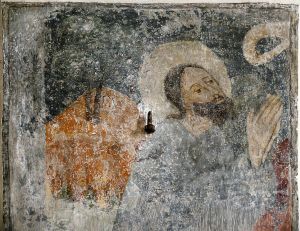 took me a long time deciding whether or not to use such an uncompromising word, but frankly I have no choice. If we really believe in God and what he has planned to do for us, has already done for us, and is doing for us now to put his plan into operation, to unite our destiny with his, then there is only one way to respond. He has chosen to give us his all, how can we do less than give our all for him.
took me a long time deciding whether or not to use such an uncompromising word, but frankly I have no choice. If we really believe in God and what he has planned to do for us, has already done for us, and is doing for us now to put his plan into operation, to unite our destiny with his, then there is only one way to respond. He has chosen to give us his all, how can we do less than give our all for him.
Read more at David Torkington
 took me a long time deciding whether or not to use such an uncompromising word, but frankly I have no choice. If we really believe in God and what he has planned to do for us, has already done for us, and is doing for us now to put his plan into operation, to unite our destiny with his, then there is only one way to respond. He has chosen to give us his all, how can we do less than give our all for him.
took me a long time deciding whether or not to use such an uncompromising word, but frankly I have no choice. If we really believe in God and what he has planned to do for us, has already done for us, and is doing for us now to put his plan into operation, to unite our destiny with his, then there is only one way to respond. He has chosen to give us his all, how can we do less than give our all for him. Read more at David Torkington
Tuesday, April 22, 2014
Learning typology with Daniel in the lions’ den
I titled this post “learning typology,” instead of “teaching typology,” because this is a subject we can adapt to any age group. Many adult Catholics are unfamiliar with typology. So if your children are grown, or you’re not a parent, read this for yourself. If you do have young children or you teach religious education, you can adapt this to your students’ ages.
If you are completely unfamiliar with typology or need a refresher course, start with my post on Teaching typology with Joseph and his brothers.
Since it is Easter, it’s a good time to look at the similarities between the prophet Daniel and Christ. The story of Daniel in the Lions’ Den prefigures Christ’s Death and Resurrection. I will go through a proposed lesson step by step for various age and skill levels.
Contineu reading at Contemplative Homeschool.
Wednesday, April 16, 2014
Some of Giving the Devil's Advocate His Due on Conspiracies and the Canonization of Pope John XXIII
In anticipation of the dual canonizations of Pope Saint John XXIII and Pope Saint John Paul II, I wanted to better understand the merits of the men whose heroic virtues the Catholic Church recognizes must be in heaven.
Contemporary memory of Pope John XXIII was that he was a portly septuagenarian Patriarch of Venice who was elected in 1958 to be a caretaker seat warmer on the Chair of Saint Peter. Yet “Papa Roncalli” audaciously called for what became the Second Vatican Council which brought the liturgy into the vernacular. “The Good Pope John” died after a pontificate of just over four years and one third of the way into Vatican II.
That thumbnail sketch of Pope John XXIII’s papacy is simplified but accurate. Yet it does not explain the apoplectic opposition from some traditional Catholics, who consider “Roncalli” an anti-pope. To better understand objections by radical traditionalist “Catholics”, I braved the fever swamps of internet intrigue, old school insider catholic baseball as well as historical peculiarities. I wanted to discern if their counter arguments were persuasive or held merit.
Those who are Sirianists strongly cling to an anomaly associated with the 1958 Conclave. The College of Cardinals were reduced to 51 electors as Pope Pius XII only held two Consistories (in 1945 and 1953) during his 19 year reign, and many of the participating Cardinals were quite elderly.
In fact two Cardinal electors died in the Interregnum prior to the Consistory so only 49 Cardinals participated. On the first evening of the Conclave, white smoke was reported coming from the Sistine Chapel indicating “Habemus Papem”. Even Vatican Radio announced: "The smoke is white... There is absolutely no doubt. A Pope has been elected." However, no Pope appeared and after perhaps twenty minutes, the smoke changed to black.
 |
| Cardinal Giuseppe Siri, Archibishop of Milan |
After votes are tallied in a Conclave, an elected is asked if he accepts the election. If so, he is asked for his desired regnal name. At that point, he is Pope. So if the Siri Thesis has merit, the Archbishop of Genoa had accepted and given the name “Gregory XVII”.
Afterwards, the vote was suppressed with threats. Yet according to the 1917 Code of Canon Law, Canon 187: "Resignation made out of grave fear that is inflicted unjustly or out of malice, substantial error, or simony is invalid by the law itself." Hence, Siri was the legitimate pope who was prevented from taking his place– Sede Impeditists– and the succeeding popes were anti-popes,. The 1958 Conclave remained deadlocked for two more days. Since Conclave proceedings are secret, conspiracy theorists string together conjecture with fragments of “facts”.
According to the intrigue, Cardinal Federico Tedeschini, an 85 year old curial cardinal, was elected as a “transitional pope” but his acceptance was immediately quashed with threats. Eventually, another transitional pope was sought, but bitter radical traditionalists bemoan that another compromise candidate the Patriarch of Venice Cardinal Angelo Roncalli, an alleged free mason, was elected Pope John XXIII on the eleventh ballot, facilitated by B'nai B'rith (Jewsish Masonic) alleged collaborator Cardinal Tisserant. Some Sede Impeditists allege that a cabal of free mason cardinals which planned a “satanic coup d’etat” to install Roncalli as the 262nd Supreme Pontiff.
[***]
As a historian, the 1958 Conclave had some interesting elements which makes one wonder. The 49 electors, with many being curial lends credence to some “palace intrigue”. Furthermore, the initial puffs of white smoke combined with confusion in the Sede Vacante Vatican on the first day of the 1958 Conclave was interesting, but inconclusive. Allegations of a fifth column or satanic coup d’etat seem like fantastic filaments in a rad/trad yarn.
[***]
Most of the radical traditional condemnations of Pope John XXIII’s reign attribute elements of change in practice (but not in doctrine) which they can not reconcile. The outreach to the Jews and the Orthodox seem anathematic to people who believe in Catholic supremacy. These radical traditionals would bristle at altering a jot or tittle of Pope St. Pius V’s one true Tridentine Missal from 1570 and would scoff at the People of God worshiping in the vernacular as they should be saying Mass in the Lord’s language of Latin (sic).
[***]
Siri intimates that he was twice elected Pope, in 1963 which he refused and for the second 1978 Conclave, which Siri supposedly was obliged to refuse to prevent a schism. Thus the source claims that Pope Paul VI and Pope St. John Paul II were anti-popes. If we choose to believe former Jesuit novelist and biblical scholar Malachi Martin, Cardinal Siri was also elected in the first 1978 Conclave. Conservative Catholics claim that Siri was elected at four conclaves but never actually assumed the Chair of St. Peter.
This sort of claim is curious. Pro arguendo, taking Cardinal Siri’s alleged claims, at face value, then what happened to his 1958 election? Cardinal Siri supposedly did not care for Pope John XXIII and despised Pope Paul VI, yet he referred to them as pontiffs. Surely a conservative Cardinal could have applied Canon Law and either disputed their elections or he could have resigned so as not to be obliged to serve under anti-popes. Yet Cardinal Siri remained as Archbishop of Genoa until 1987.
[***]
Reading plethora of scant sources of radical traditionalists on the matter, it seems that they will seize upon anything to confirm their suspicions against Modernism, Free Masonry, Internationalism (the New World Order) and even more sinister conspiracies. The sketchy sourcing calls into question their conclusions, but their contention is that Free Masons also control messaging in the Church and secular sources would not contradict their corrupted Church conspirators.
I found several striking leitmotifs in the radical traditionalist critique of “The Good Pope John”. That very moniker originates from the world-wide affection for the portly pontiff, who was able to be companions to those on the margins. No where in their literature was any good perceived from (anti) Pope John XXIII’s reign. Perhaps this should not be a great surprise as most of them condemn all Popes from 1958 onward to be anti-popes.
[***]
After reading many radical traditional assessments of the Siri Thesis and conspiracies about (anti) Pope John XXIII sound like the fare common on Art Bell’s Coast to Coast AM, which Malachi Martin was a frequent guest. These challenges to Pope John XXIII parallel conservative critiques and rejection of Vatican II longing for the days of glory epitomized in the Tridentine Mass. So questioning the authenticity of Pope John XXIII’s election by the College of Cardinals conveniently vitiate any innovations of the Council and their successors without thinking themselves as schismatic. The shifting narratives of the Siri Thesis (if one believes various sources, being elected but impeded in 1958, 1963 and twice in 1978) along with the ad hominem attacks on Pope Paul VI and Pope John Paul II sound more like sour grapes than serious charges.
[***]
Understand that radical traditionalists object to the “aggornamento” (updating) which the Second Vatican Council brought to the Catholic Church which shifted control of the Vatican from a clubby curia and failed to treat the Church like a museum. Hence, attacking the Shepherd to takes them to that place discredits him while driving home their traditionalist message.
[***]
It would behoove believers to examine the heroic virtues of Pope St. John XXIII rather than delve into Sede Impeditist and Sede Vacante fever swamps. Or as Pope St. John XXIII put it: "The habit of thinking ill of everything and everyone is tiresome to our selves and to all around us."
SEE MORE at DCBarroco.com
Tuesday, April 15, 2014
Keeping watch with Jesus--unexpectedly
 |
| Memorial to the Japanese martyrs of Unzen. (Photo by Connie Rossini.) |
This is the week for keeping watch with Jesus in a special way. Although God calls us to spend time with Him in prayer daily, we rightly feel that we should spend extra time with Him during Holy Week. But how should we go about it?
When I was a teenager, my family started a tradition of an all-night prayer vigil on Holy Thursday. Beginning at 10 p.m., my parents, siblings, and I took turns praying in one or two one-hour slots for the next eight hours. I loved offering this extra sacrifice to Jesus, this extra sign of love. Jesus would not be alone in the Garden of Gethsemane if I could help it.
After I graduated from college, I spent two years as a lay missionary in Japan, teaching English to support the evangelization work of an American priest. During spring break of the first year, my roommate Mary Beth and I traveled to the island of Kyushu. We planned to be in Nagasaki for Easter.
On Holy Thursday we were in the resort town of Unzen. Known for its hot springs, in which the Japanese bathe for health, Unzen is also the site of mass martyrdoms in the 17th century. In one of the most heinous instances of torture in history, Japanese officials hung Catholics upside-down to slowly roast over the hot springs. They punctured holes in the martyrs’ foreheads, so that the rush of blood to their heads would not kill them prematurely.
Read the rest at Contemplative Homeschool.
Thursday, April 10, 2014
Pope Francis Condemns Slaying of Dutch Jesuit in Syria
Dutch Jesuit Fr. Francis van der Lugt was brutally murdered in Homs, Syria by masked gunman. The septigenarian cleric was beaten by a masked man on the street in front of the Jesuit monastery in Bustan al-Diwan, a Christian portion of the Old City, and then he was shot twice in the head.
Fr. van der Lugt who was a trained psychotherapist, had spent fifty years living in Syria ministering to disabled people at the Al Ard Center near Homs. The Center also took in refugees from the Syrian Civil War, but that mission curtailed as the staff fled since they could not ensure the safety of their guests. Fr. van der Lugt tried to be a companion to those in mental distress and give them as much food as possible.
Fr. Frans refused to be part of the February 2014 UN supervised evacuation of 1,400 people from the city, which had been besieged for a year and a half. In the Old City of Homs, the Christian population had shrunk from tens of thousands to just 66. Christians used to make up 10% of the Syrian population before the Civil War, but Christians have been brutalized for their faith during the conflict Fr. van der Lugt reasoned that he was the only priest remaining to minister to his people so how could he leave.
In January, Fr. van der Lugt made pleas through the media that gained world-wide attention to have humanitarian aid sent to the city to feed the starving Muslim and Christian population.
This led to meeting with UN officials to receive aid and hear first hand accounts of the humanitarian trials in Homs. Fr. van der Lugt procured four kilos of kilos of flour a week from a Muslim charity so that he could make bread and distribute half a loaf to the enclaves neediest 30 people.
[***]
Fr. van der Lugt's selfless dedication to his fellow man and openness to serve the Lord even unto death
echos the ultimate sacrifice that our Lord Jesus Christ which we will celebrate next week in the Triduum.
SEE MORE at DC-LausDeo.US
Tuesday, April 8, 2014
What's the Little Way got to do with detachment?
 |
| Monument to St. John of the Cross in Frontiveros, Spain. |
You can’t read the Carmelite saints for long without encountering the idea of detachment. We find it in the writings of John of the Cross, of Teresa of Avila, and even of St. Therese. Detachment for Catholics is not the same as mere penance. Detachment, like the entire spiritual life, begins and ends with love.
St. John of the Cross is the master teacher about detachment. Here is his famous passage on detachment from The Ascent of Mount Carmel:
Endeavor to be inclined always:Do I detect a few sighs?
not to the easiest, but to the most difficult;
not to the most delightful, but to the most distasteful;
not to the most gratifying, but to the least pleasant;
not to what means rest for you, but to hard work;
not to the consoling, but to the unconsoling;
not to the most, but to the least;
not to the highest and most precious, but to the lowest and most despised;
not to wanting something, but to wanting nothing.
If we read this passage out of context, the spiritual life appears dry, difficult, and even impossible. We are tempted to give up before we even begin. We reject John of the Cross and move on to another saint whose teaching appears less demanding.
What if I told you that St. Therese practiced perfect detachment? What if I told you her Little Way makes the same demands as John’s Ascent? Let’s look at the passage again in light of the life and teaching of St. Therese.
Read the rest at Contemplative Homeschool.
Tuesday, April 1, 2014
Family and homeschool activities for the rest of Lent
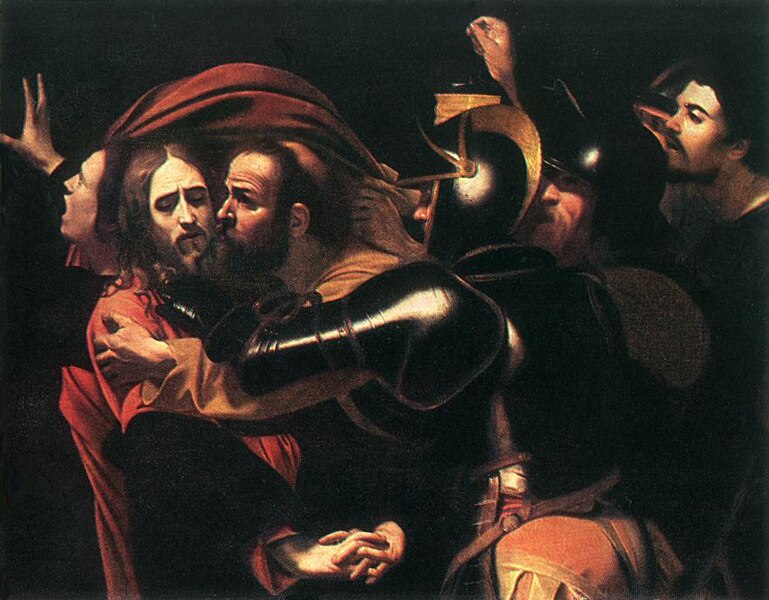
Ready to celebrate the rest of Lent as a family? Here are several activities you can do together, whether or not you homeschool.
p=suitable for grades 1-3
m=suitable for grades 4-6
j=suitable for grades 7-9
s=suitable for grades 10-12
Books
Besides reading the Gospel accounts of Holy Week, try reading and discussing the following books that deal with sacrifice, martyrdom, or resurrection:The Velveteen Rabbit by Margery Williams (p).
The Tale of Three Trees by Angela Elwell Hunt (p+).
The Queen and the Cross: The Story of St. Helen by Cornelia Mary Bilinsky (p, m)
The Lion, the Witch, and the Wardrobe by C. S. Lewis (p+ for reading aloud; m+ for independent reading).
Continue reading at Contemplative Homeschool.
Subscribe to:
Comments (Atom)

.jpg)


